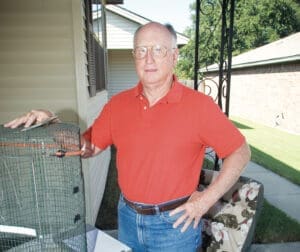By Jamie Zimchek
 Fred Bassett bands birds, hummingbirds generally, over 35,000 of them specifically. If this fact does not at once boggle the mind, spend a second considering the logistics. To band a hummingbird, you have to catch a hummingbird. Having caught this tiny, flighty hummingbird, you have to fit the tiniest of little bands on the tiniest of little hummingbird legs. Take for example the Calliope hummingbird: it’s the smallest bird native to North America, and with a top length of about 3.9 inches you can bet its legs are very, very tiny. Yet Fred makes banding these delightful creatures look almost simple. “People see me banding birds and think it’s really easy, you don’t have any clue how much work goes into this,” he says with a laugh.
Fred Bassett bands birds, hummingbirds generally, over 35,000 of them specifically. If this fact does not at once boggle the mind, spend a second considering the logistics. To band a hummingbird, you have to catch a hummingbird. Having caught this tiny, flighty hummingbird, you have to fit the tiniest of little bands on the tiniest of little hummingbird legs. Take for example the Calliope hummingbird: it’s the smallest bird native to North America, and with a top length of about 3.9 inches you can bet its legs are very, very tiny. Yet Fred makes banding these delightful creatures look almost simple. “People see me banding birds and think it’s really easy, you don’t have any clue how much work goes into this,” he says with a laugh.
Based in Montgomery, Alabama, Fred is a traveling bird bander with a range that takes in South Alabama, South Georgia, and Florida using the mobile work station he’s assembled in his truck. He’s been at it since he retired from the Air Force nearly 30 years ago and met a couple running a bird banding station at Fort Morgan (Alabama). He spent the next 20 years volunteering at the bird banding station for a few weeks in the spring and fall. At some point, he fell for hummingbirds. “When I started banding hummingbirds, it pretty much took over my life,” Fred says. He, like many others, fell under the spell of these almost magical birds – or rather these fairies/birds/angels — and has now been banding them for over 25 years.
Just how do you get to be a hummingbird bander? “You have to have really good eyesight,” Fred notes. Beyond that, you also have to receive special certification, a process that involves a lot of hands-on training, a written test, and then a banding in front of a panel. “You have to demonstrate that you can identify all the different species, and age and sex them correctly.” For hummingbirds, a pair of banding pliers is reworked to handle the minuscule bands. These bands come to the banders in strips that are cut apart into lines of 10, then cut to the right length depending on the birds they’re intended for – a hummingbird band might only be 5.4 mm long before it’s rolled. But testing isn’t just about technical details. There’s also a section on banding ethics, and how to deal with the public. Finally, once you’re a certified bander any birds banded are reported to the National Bird Banding Laboratory. Then, if the bird you banded several months back in Tallahassee turns up in Alaska, say, the original bander is notified and the new sighting also entered into the system. For researchers, bird banders are crucial; they provide the raw data that can then be analyzed to see bird migratory patterns and habits. “You can’t even get a permit to band unless you have a research project that you’re going to publish on,” explains Fred. “That stops about 95% of the people right off.”
Let’s assume you’re not aiming for actual bander status but excited to attract more hummingbirds to your yard so that Fred Bassett can come band them for you. Definitely go first to the website he founded, www.hummingbirdresearch.net. In addition to recommended plant lists and feeder information, find also details on ongoing research projects and local banders. For a fascinating dive into hummingbird habits and habitats, watch his two part series on hummingbirds which starts with summer hummingbirds here: www.youtube.com/watch?v=5SFqwM5J5aM. If images of tic tac-sized hummingbird eggs and tales of 18 hour solo flights across the Gulf of Mexico don’t make you want to rush right out to buy a feeder to attract some winter hummingbird visitors, nothing will.
How do you know when to call Fred? “In the winter if someone sees a hummingbird for a day or so, I’d have them contact me and I’ll talk to them. If there’s a good chance it’s a rare hummingbird I’ll come as fast as I can.” Make sure you’re seeing these birds on a semi-regular basis between November 15 and March 1 first. Also, since Fred puts a feeder in a trap to catch them for banding, they need to be feeding at a feeder, not just flowers.
So get your sugar water proportions right, place your feeder, and find a comfortable spot to do some winter hummingbird watching. Watch out though – it just might take over your life (in the best kind of way).
Reach Fred Bassett at fhound@aol.com or (334) 868-9658.





















































